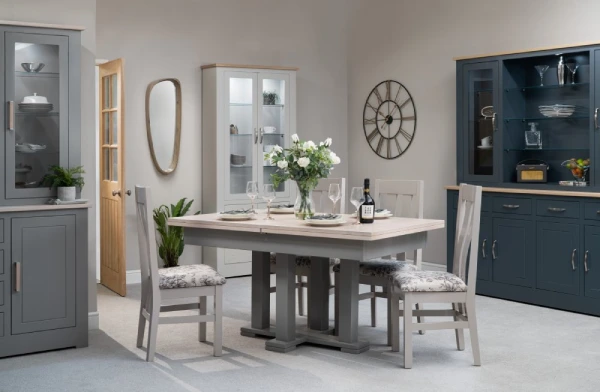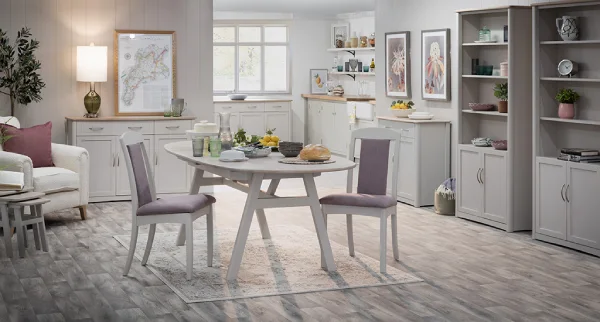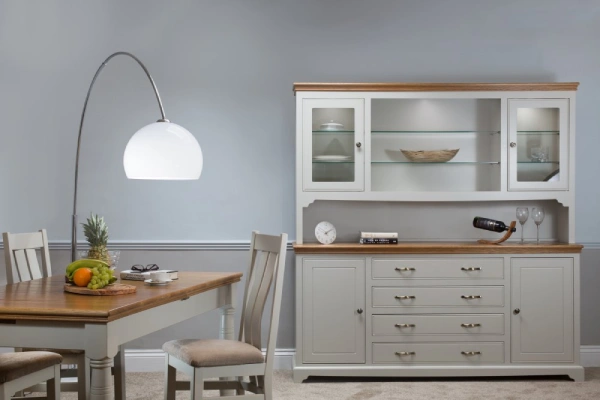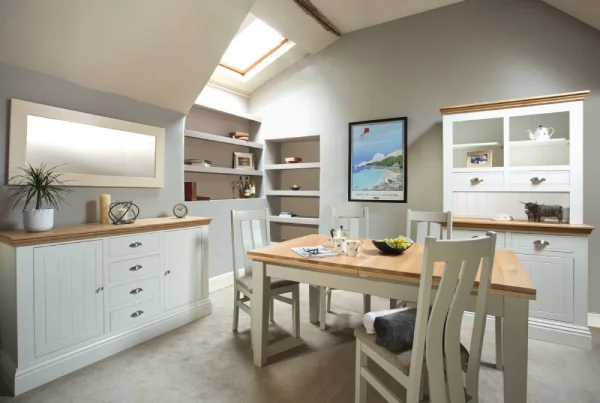This article is provided by Painted Furniture Company.
Designing a dining room in your first home is a venture filled with possibilities and personal touches. It’s where daily meals transform into cherished gatherings and where style meets functionality. The choices you make, from the colour palette to the furnishings, set the tone for countless memories.
As you embark on this decorating journey, consider how each element, big or small, contributes to the overall ambience of your home’s dining area.
Best Colours for the Size of the Room

Image by Painted Furniture Company
Choosing the right colour for your dining room can greatly influence its ambience and perceived size. Lighter shades like pastel blues, soft greys, or gentle creams are perfect for smaller dining areas, as they reflect more light, making the space appear larger and more open.
For more spacious rooms, you can experiment with bolder colours like deep navy, rich burgundy, or earthy terracotta, which add a sense of warmth and sophistication. When selecting colours, it’s also important to consider the room’s natural light and how it interacts with different hues throughout the day. A harmonious colour palette that balances walls, furniture, and accessories creates a cohesive and inviting space.
Understanding Your Spacing Needs
The key to a well-designed dining room lies in understanding and optimising your space. Start by measuring your room to determine the ideal size for your dining table. You’ll want to ensure there’s ample space for chairs and easy movement around the room. Consider the flow between the dining area and adjacent rooms.

Image by Painted Furniture Company
If your dining area is part of an open-plan layout, think about how the dining furniture will complement the surrounding spaces. Also, consider multifunctional furniture that can adapt to different needs, like extendable tables or stackable chairs, to make the most of your space.
Choosing Furniture for Your Dining Room
Selecting the right furniture is essential in creating a dining room that is both functional and stylish. Understanding which dining room table shape is best for you is a key part of this process. The dining table, being the centrepiece, should suit the size and shape of your room.

Image by Painted Furniture Company
For smaller spaces, round or oval tables can be more space-efficient, offering flexibility and ease of movement. Conversely, larger rooms can comfortably accommodate rectangular or square tables, providing ample space for dining and entertaining. When it comes to chairs, comfort is crucial for long dinners, and the style should complement your table.
Additionally, sideboards or display cabinets not only offer additional storage but can also serve as an attractive focal point. When selecting these pieces, pay attention to the material and finish, ensuring it harmonises with the overall aesthetic of your dining area furniture, consider the material and finish, ensuring it aligns with the room’s overall aesthetic.
Lighting and Decor for a Welcoming Ambience

Image by Painted Furniture Company
The best lighting and decor can transform your dining room into a welcoming and stylish space. A statement lighting fixture, like a chandelier or a set of pendant lights, can be both a focal point and a source of ambient light. Consider adding a variety of light placements, with wall sconces or floor lamps to create a warm and inviting atmosphere.
Decor items such as mirrors can visually expand the space and enhance natural light, while art pieces or a gallery wall can add a personal touch. Don’t forget the fine details like table centrepieces or decorative vases, which can add character and charm to the room.
Essential Dining Table Checklist for First-Time Homeowners
There are many priorities for first-time homeowners to consider when it comes to searching for their first home to buy. Once the hard tasks of setting a savings goal and finding the right mortgage are behind you, you can start to focus on what you might need to buy for your new home too.
For your dining room, there are many essential items that you might need to buy new for your new space or decide to replace for your new home. Start with the basics: durable and versatile dinnerware that includes plates, bowls, and glasses. Choose cutlery that feels comfortable to hold and complements your dinnerware. Napkins, placemats, and a tablecloth not only protect your table but also add colour and texture.
Consider other essentials like a water jug, salt and pepper shakers, and serving dishes. These items are more than just functional; they contribute to the overall dining experience and reflect your personal style. Choose items that you love and that will make mealtimes special.
Working With A Kitchen-Dining Room
Designing a dining area in a space shared with the kitchen requires a thoughtful approach to maintaining both functionality and style. In a kitchen-dining room, it’s important to create a seamless transition between cooking and dining spaces. Opt for a cohesive colour scheme and complementary materials to unify the two areas.
Consider a bar or island that can double as both a meal prep area and a casual dining spot. Efficient storage solutions are key to keeping the space clutter-free and pleasant. This integrated approach not only maximises the utility of your space but also fosters a sociable environment where cooking and dining blend harmoniously.
Personalising Your Dining Room
Personalising your dining room is all about reflecting your unique style and preferences. Artwork is a great way to express your personality; choose pieces that resonate with you, whether they’re bold contemporary prints or serene landscapes. Consider incorporating family heirlooms or travel souvenirs to add a layer of personal history.
Textiles like hand-woven rugs or custom curtains can introduce colour and texture, enhancing the room’s comfort and visual appeal. Plants can also bring life and freshness into the space. The key is to select items that you connect with, creating a dining area that feels truly your own.
